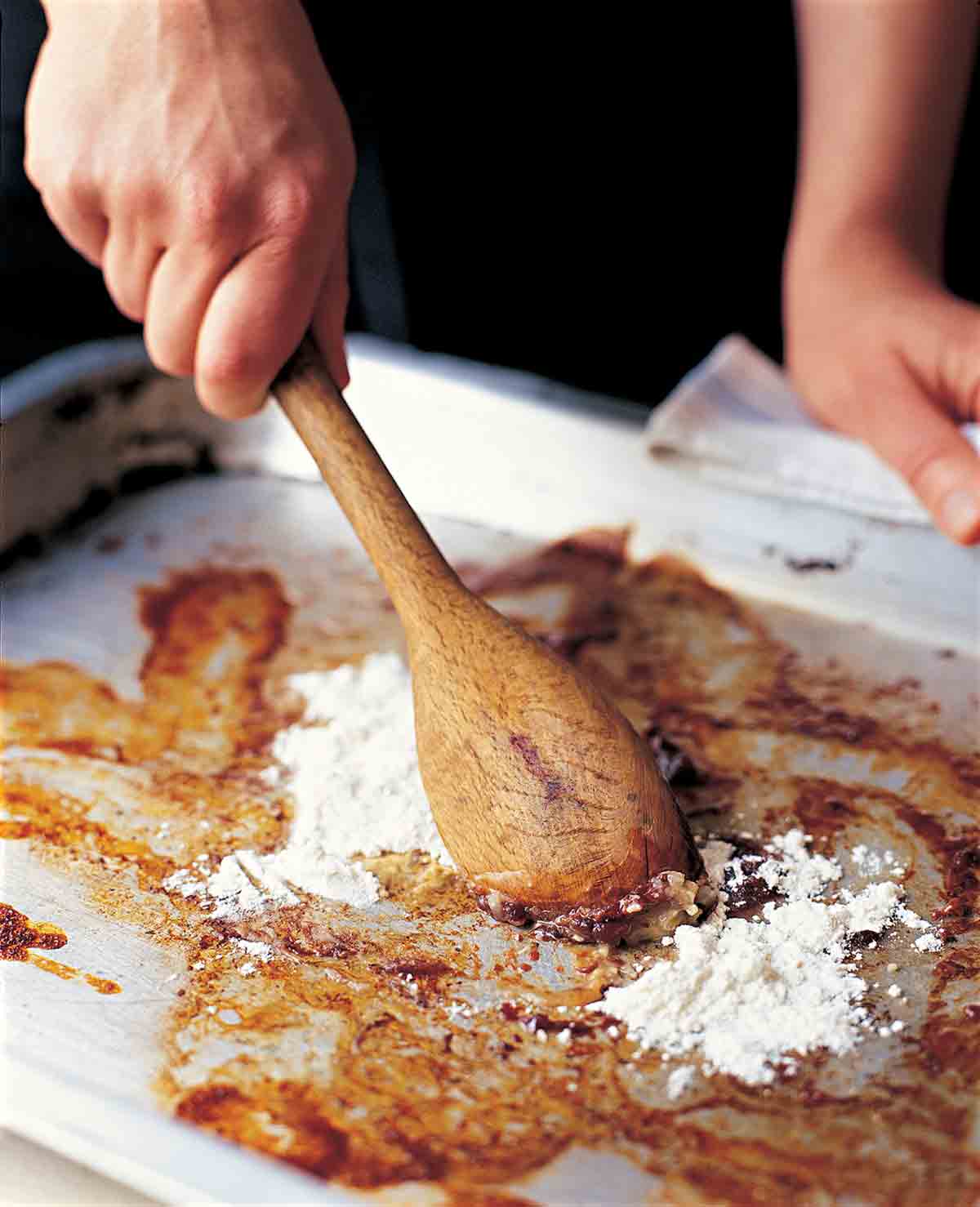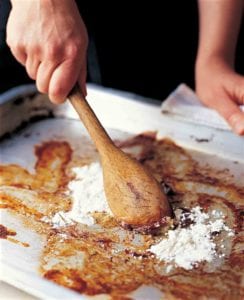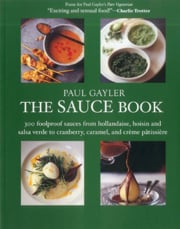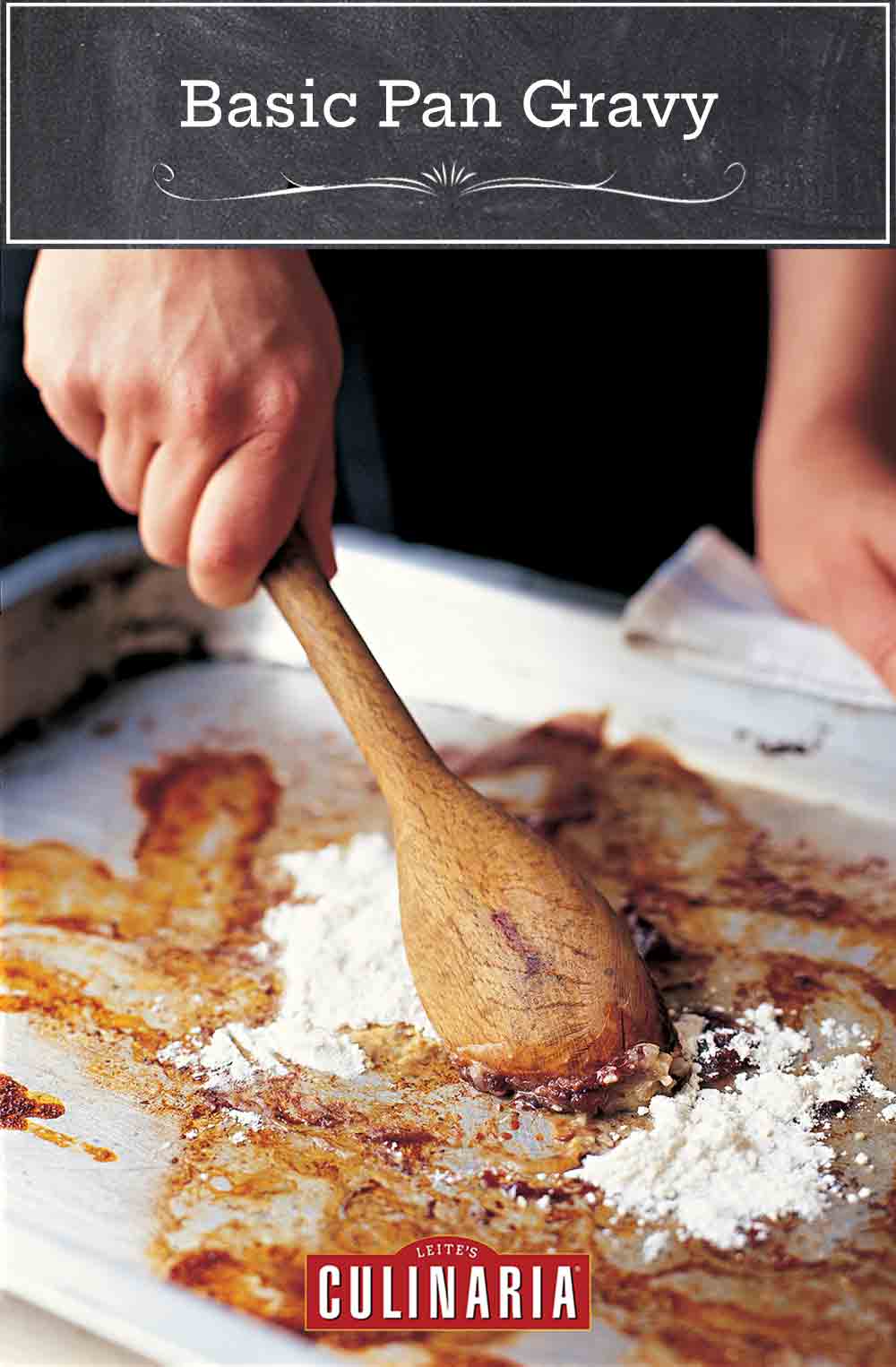
This basic pan gravy recipe is a cinch to make. No fuss. No mess. No lumps. Just easy, foolproof gravy. Which isn’t as easy to pull off as you may think. Because great gravy doesn’t happen by accident. Here’s how it does happen. Complete with instructions outlining every last detail of how to make it.

Why This Recipe Works
Yes, this gravy is built on the holy trinity of gravy-making—fat, flour, and stock. But more importantly, it harnesses those crusty, caramelized brown bits stuck to the bottom of your roasting pan, the result of the Maillard Reaction. They’re flavor bombs just waiting to be unleashed.
Letting the flour cook just long enough to lose its raw taste (nobody wants their gravy tasting like library paste) is the trick here. The result is silky, rich, and exactly what your mother will assume came from a packet. (But we know better, don’t we?)
The short answer is don’t even try. Seriously. The saltiness in the pan drippings will truly overpower everything else in your gravy. Sorta like a narcissist dominating the conversation at a cocktail party. There’s just no chance of salvaging the situation. Don’t even bother.
Too thin? Let it simmer until it reduces to your desired consistency. Every minute of simmering concentrates the flavor, so there’s no downside here. If you’re in a hurry, whisk in some cornstarch slurry (cornstarch mixed with cold water).
Too thick? Add more stock, a little at a time, while whisking. Remember: you can always thin it out, but thickening takes more time.
Absolutely. Let it cool completely, transfer to an airtight container, and freeze for up to 3 months. When ready to use, thaw overnight in the fridge and reheat gently on the stovetop. Don’t let it boil – that’ll make your gravy break and turn grainy. Give it a good whisk before serving to smooth out any separation
Write a Review
If you make this recipe, or any dish on LC, consider leaving a review, a star rating, and your best photo in the comments below. I love hearing from you.–David
Video: How to Make Pan Gravy

Basic Pan Gravy
Ingredients
- pan drippings, from a roast beef, chicken, turkey, guinea hen, pork loin, or other cut of meat (NOT a brined cut of meat)
- 3 tablespoons all-purpose flour
- 2 1/2 cups homemade stock, warmed (use a chicken stock for roast chicken, turkey stock for turkey, beef stock for roast beef, and so on)
- Salt and freshly ground black pepper
Instructions
- After roasting the meat, transfer it to a warmed platter or plate and set aside to rest.
- Skim the excess fat from the surface of the liquid that collected in the roasting pan, leaving about 2 tablespoons the pan drippings mingled with a little fat.
- Place the roasting pan over 1 or 2 burners on medium heat.
- Using a wooden spoon, scrape up the caramelized pan juices, then sprinkle the 3 tablespoons all-purpose flour over the top, stirring constantly to blend it well with the fat and juices. Cook, still stirring constantly, until the flour becomes a light golden color, about 2 minutes.
- Still stirring, slowly add the warm 2 1/2 cups homemade stock to the roasting pan. Bring to a boil and cook—say it with us, still stirring constantly—until the sauce thickens and the mixture is reduced by about a third and has a gravylike consistency.
- Season the gravy with Salt and freshly ground black pepper to taste. If desired, strain through a fine-mesh strainer. Serve immediately.
Notes
Gravy Variation
Herb and Mustard GravySimply add a small handful of your favorite herbs, such as rosemary, thyme, or sage, to the gravy as it reduces. Whisk in 1 tablespoon of Dijon mustard before straining. Wine Gravy
Substitute 1/3 cup of red wine, port, or white wine for 1/3 cup of stock and add it gradually, as you did with the stock. Beer Gravy
Add a 12-ounce bottle of dark beer to the gravy in place of 1 1/2 cups of stock. Wonderful with roast beef or pork.

Nutrition
Nutrition information is automatically calculated, so should only be used as an approximation.
Recipe Testers’ Reviews
I think this is a great basic pan gravy to keep on hand when you make any roast item that needs a gravy. This would make a super easy Thanksgiving gravy as well as Easter roast gravy or anything else. I didn’t try any of the variations, but I think that each would work great!
This is a great way to make pan gravy for a roast—even if you don’t have enough drippings. The roast I cooked didn’t surrender enough drippings, so I improvised by adding some butter. Sure enough, the roux yielded a fantastic sauce for our roast beef. I used the wine variation, adding 1/2 cup port for a well-rounded gravy, and everyone loved it.
This pan gravy is foolproof, easy, and has demonstrated that it’s really versatile.
My slightly alternative approach was to substitute the braising liquid from a big pile of short ribs for the roast pan drippings. I chose the herb and mustard variation. I added a heaping tablespoon of chopped fresh herbs rather than a small handful of dried herbs. It tasted perfect, and I didn’t have to strain the herbs out.
This is a nice way to end up with pan gravy after making any of a wide variety of roast meats, poultry, or game. It’s pretty straightforward and open to many variations. I tried a beer gravy to use up the rest of the bottle of beer I had opened when making the Wheat Beer Chicken.
I had some beautiful fresh thyme, so I added that to the gravy also. I cooked some vegetables and used the leftover chicken and gravy to make a crustless chicken potpie. There are even leftovers for tomorrow, all after having a nice amount of gravy to begin with.














I have to pass on Shirley O. Corridor’s mother’s tip for gravy because once I tried it I never went back. Shirley says her mom used to throw a handful of bread stuffing into the bottom of the roasting pan when the turkey went into the oven. While the turkey roasts the bread is sopping up all those fats and the veggies and herbs are rendering down into the excess juices.
When the turkey comes out of the oven you put it in your microwave — that big insulated box that will hold the temperature — to rest. Now add a bit of liquid — broth if you’ve got any left but don’t dismiss the tasty seasoned potato cooking water — right into your roasting pan and whirl it all to liquify with a hand blender. Then you can taste and add more liquid to a good ratio with the juices and roasty bits and, if necessary add a bit of flour stirred first into cool liquid to thicken to taste.
It will be tasty. It will be lump free. You won’t go back to plain flour.
Wow, rainey, thank you! I’d never heard this before and it is, indeed revelatory! Happy, happy Thankgiving!
I know. It came at me as a bolt of lightening after decades of doing traditional gravy. But what more vaunted recommendation can you get than Shirley O. Corriher and the woman who taught HER to cook?!
It’s the identical thickening agent as flour but in the form of bread it WON’T gelatinize and lump up like flour. And it’s tastier with all the herbs and aromatics. How can you lose?
Nods. Exactly, Rainey. Exactly.
Team “Lake of Gravy”! I think there should be thanksgiving t-shirts saying so much. Just had to comment because that cracked me up!
We should order some, right, CakeSpy?!
Why pour off all but 2 tablespoons of the fat when you can just make more gravy than the 1 2/3 cups you’ll have with the above formula? My family would kill me if there was not a lake of gravy available not only for that dinner but for use with leftovers (and french fries, if you like).
An excellent question, Soupçon. I guess not everyone appreciates a lake of gravy, and so the recipe developer and cookbook author was simply trying to be modest. But by all means, do as you suggest!